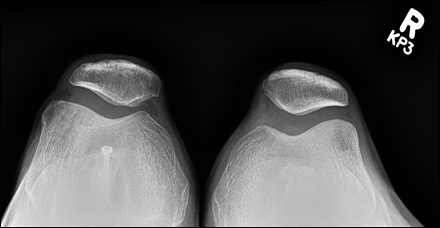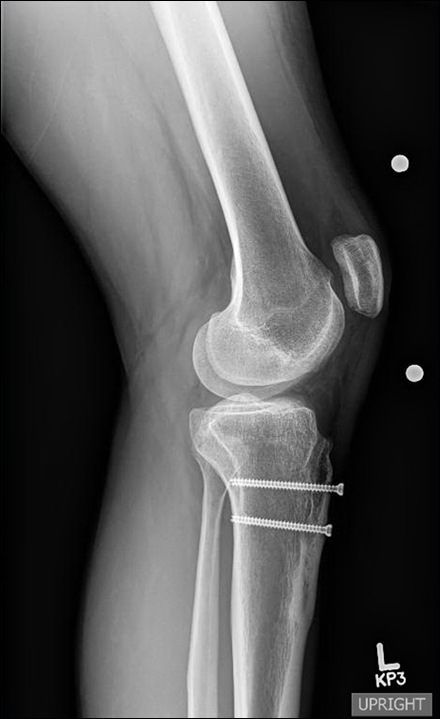Tibial tubercle osteotomy: Soft tissue stabilization may be required to completely correct maltracking
The indications for distal realignment as part of the treatment for recurrent patellofemoral instability are based upon limited evidence. For patients without bony malalignment, soft tissue stabilization is typically undertaken without distal realignment.
Medial patellofemoral ligament (MPFL) reconstruction has become an accepted method of soft tissue stabilization, as repair of the injured medial structures has been shown to have an unacceptably high rate of failure. For patients with recurrent patellofemoral instability, bony malalignment in the sagittal plane (patella alta) and/or coronal plane (high Q angle or tibial-tubercle-to-trochlear-groove distance) is supported by expert opinion as a surgical indication for distal realignment in the form of medializing or anteromedializing tibial tubercle osteotomy. No studies have specifically addressed whether distal realignment should be undertaken along with soft tissue stabilization or in isolation. Some surgeons might perform distal realignment only, under the assumption that medializing the insertion of the patellar tendon would account for any medial soft tissue laxity.
Recurrent instability

Figure 1: A Merchant view shows left knee anteromedializing tibial tubercle osteotomy and resultant medialization of the patella within the trochlea compared to right
Credit: Munch J
Anecdotal reports of recurrent instability after isolated tibial tubercle osteotomy hint that distal realignment may not be sufficient to stabilize the patellofemoral joint in the setting of instability and bony malalignment. Trochlear dysplasia and patella alta inevitably affect tracking of the patella in early knee flexion, and perhaps isolated tibial tubercle osteotomy, without a checkrein to lateral tracking of the patella before it is engaged sufficiently within the trochlear groove, could allow persistent maltracking.

Jacqueline Munch
Perhaps an unrecognized rotational component contributes to the recurrent instability: femoral anteversion, for instance, is thought to promote a valgus and internal rotation moment across the knee and, therefore, worsened patellar tracking. Finally, the chronic laxity of the medial soft tissues in the setting of recurrent instability may remain pathologic in the absence of surgical correction. Biomechanical studies have shown that the medial patellofemoral ligament provides 60% of the restraint to lateral translation of the patella. Recurrent instability or maltracking after isolated tibial tubercle osteotomy might be due to failure of the injured MPFL to act as a checkrein during early range of motion, even though the patella tracks more medially within the trochlea with deeper knee flexion.

Figure 2: A lateral view demonstrates healed tibial tubercle osteotomy and evidence of patella alta, as well as Dejour type B trochlear dysplasia: supracondylar spur and crossing sign
Credit: Munch J
Case example
Figure 1 and Figure 2 demonstrate the bilateral knee merchant view and lateral view X-rays of a patient who underwent left knee anteromedializing tibial tubercle osteotomy and lateral release in 2010. The patella is obviously medialized within the trochlea on the left compared to the right. The lateral view demonstrates evidence of patella alta, as well as trochlear dysplasia in the form of a crossing sign and a supratrochlear spur. After surgery, the left patellofemoral joint never dislocated, or even subluxated, again. Thus, this patient’s isolated tibial tubercle osteotomy might be called a success.
However, the video demonstrates the patient’s examination: with range of motion, he exhibits a dramatic J-sign of the patella, which he finds bothersome. The persistent J-sign might have been eliminated by MPFL reconstruction to restore the patient’s checkrein to lateral patellar translation. This patient had presented to clinic seeking hardware removal, and after a discussion of his continued maltracking, elected to continue in his current state without further stabilization of his patella.
Further clinical and biomechanical studies are needed to closely examine the effects of surgical stabilization of the patellofemoral joint and determine the specific surgical indications for MPFL reconstruction and tibial tubercle osteotomy. The potential for persistent maltracking in the form of a J-sign, or even recurrent instability following surgery, must be considered when decisions are made regarding the addition of soft tissue stabilization to distal realignment.
References:
Arendt EA, et al. Knee Surg Sport Tramatol Arthrosc. 2011; doi:10.1007/s00167-011-1516-y.
Desio SM, et al. Soft tissue restraints to lateral patellar translation in the human knee. Am J Sport Med. 1998;26(1):59-65.
For more information:
Jacqueline Munch, MD is an assistant professor in the Department of Orthopaedics and Rehabilitation at Oregon Health and Science University in Portland, Ore.
Disclosure: Munch reports no relevant financial disclosures.
